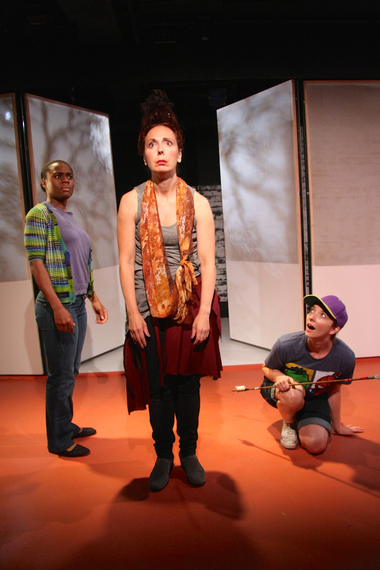Though the average American theatergoer has not seen a play from the classical Japanese theatrical style of Noh (Nō) theatre, they likely have seen playwrights influenced by that style. Bertolt Brecht conceived of his idea of verfremdungseffekt ("distancing effect," often mistranslated as "alienation effect") after watching Noh plays. Brecht misunderstood that, for the upper class audience of this centuries old form, the stylized elements don't seem any stranger than the conventions of operas do for an operatic audience.
I admit that I'm eager to give you all much more background on Noh theatre, now that I have the opportunity, but I will instead leave most of that work to Chiori Miyagawa's new play This Lingering Life, now playing at HERE Arts Center. This play is very interesting, not only because it gives me chance to talk about Noh theatre, but more so because it manages to bring something of the essence of Noh theatre into an entirely western theatrical context in a way I've never seen before.
Miyagawa's plays have always struck me first with their impressive ability to create worlds. You might be thinking that every play is its own world, but actually most of the theatre today tries to fit into this world a bit too much for my take. Miyagawa's plays, this one especially, sit somewhere between this world and another world. They also commit so fully to their own aesthetic that I usually find myself pondering the fascinating rules of this alternate existence hours or even days later (this lingering life indeed).
This Lingering Life is a complex, yet seamless, weaving-together of nine Noh storylines. Noh plays fall into five categories and are done on the same set with very stylized costumes, intonation, movements, music, and character roles. The texts are short, but the performances are long. Miyagawa's contemporary contemplation of the world of Noh takes place in modern times, on a flexible, but minimalist set (designed by Kate Noll). A series of panels, covered in white scrim-like fabric and moved by the actors, change the scenes. The rest is done by the cast of talented actors, four of whom are from Cake Productions.
This is what I meant when I said that Miyagawa has managed to capture something of the essence of Noh. I do not mean, nor do I think she intended, that this would be the same thing as seeing a Noh play, but rather she managed to take some of the most important philosophical aspects of Noh and make them more palatable to an unfamiliar audience.
For example, the aspect of time is very important in Noh. There are a great number of ghosts who come back again and again because they cannot find peace. This cyclical aspect is also repeated by the fact that the most famous writers of Noh, Kan'ami and his son Zeami, wrote plays in the 14th and 15th centuries and have had their plays done repeatedly since that time. The stories repeat in the theatre the same way the characters' lives repeat in the stories. This is clearly articulated and engaged with in This Lingering Life, as is the idea of karma in the Buddhist basis of these plays.
Another aspect of Noh that translates well in this piece is the casting. Men play all roles in Noh, though there are female characters in the plays. Indeed one of the five Noh categories is referred to as "Woman Plays". This Lingering Life modernizes this aspect by having men and women both play men and women, and also by having a more diverse cast than one generally gets to see on stage these days. These aspects both showcase the versatility of these actors while simultaneously allowing us to look through their bodies to the story itself. They also manage this without masks, which Noh plays traditionally use.
Though I am familiar with this form, the friend who joined me at the theatre was not, and still enjoyed the show. She confirmed what I suspected to be the case: that the play actually teaches you about its own interpretation of form as it goes. So, if you don't know anything about Noh, don't let that stop you from going to the show!
I will say that this is a different kind of play, which means that it might take a few minutes to get adjusted to the new style. But if you just trust Miyagawa, director Cat Miller, and the talented cast (Ronald Cohen, Amir Darvish, Francesca Day, Luke Forbes, William Franke, Vanessa Kai, Marta Kuersten, Meg MacCary, Enormvs Muñoz, and Stephanie Weeks), you will be in for a great night at the theatre. There is an especially wonderfully theatrical moment at the end that I don't want to ruin, but you should definitely wait for.
If you're curious to see something different on stage, written by someone who truly wants to experiment with form, and who is intelligent and witty about it, go and see This Lingering Life by Chiori Miyagawa. If you do know about Noh theatre, there will be jokes there just for you! If not, you will learn a lot without. Either way, This Lingering Life is a Noh Aesop's Fables, and one that nōbody should miss.


